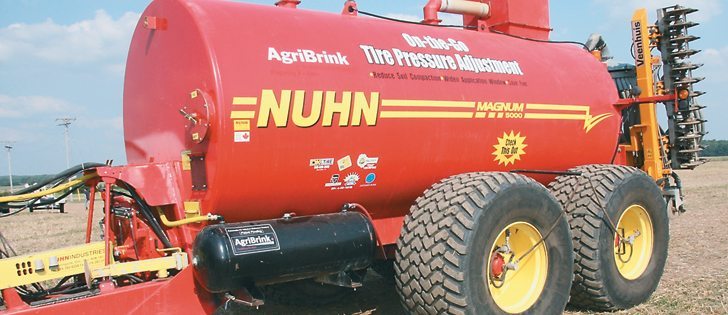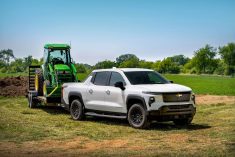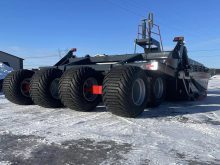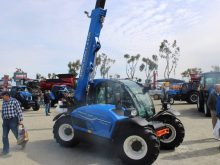When it comes to keeping tires inflated at the correct pressure, statistics say prairie people are doing a poor job.
In a recent survey conducted for The Rubber Association of Canada, 99 percent of prairie motorists were aware of how important tire inflation is to safety and fuel economy. That’s the good news.
The bad news is that only 22 percent of motorists in Manitoba and Saskatchewan check their tire pressure monthly, said Carolyn Goard of the Rubber Association of Canada. That compares to 31 percent of motorists in the rest of the country.
Read Also

Growing garlic by the thousands in Manitoba
Grower holds a planting party day every fall as a crowd gathers to help put 28,000 plants, and sometimes more, into theground
Goard said the data indicates under-inflated tires cost Canadian drivers $675 million a year in fuel purchases. Soft tires are also a safety concern, she said.
“Under-inflated tires have poor traction, faster tread wear and they make the vehicle unstable going around corners,” says Goard.
Dual truck tires are even more notorious for being out of balance. One dual hides low pressure in the other until a load is added. Then, one or both tires fail quickly.
“These are all safety factors. Results of the survey tell us drivers just don’t take the safety issue or the fuel consumption issue very seriously,” she said.
The survey also found:
- 37 percent of Manitoba and Saskatchewan motorists don’t know where to find the correct inflation pressure for their vehicle.
- Most drivers don’t know that tire pressures should be checked only when tires are cold.
- Many drivers incorrectly inflate their tires to the pressure stamped on the tire’s sidewall. This imprinted air pressure refers to maximum inflation under load. Prolonged driving at this pressure may result in uneven tread wear and reduced traction, particularly on slippery road surfaces.
- Among drivers who don’t check tire inflation monthly, many think they only need to check when it appears tire pressure is low.
- Many drivers don’t measure their tire pressures monthly because their vehicle has a tire pressure monitoring system.
“That’s another big problem. People have false confidence in their automatic monitoring system,” says Goard,
“I regularly hear people say things like ‘Oh, I don’t have to check my tire pressure anymore because I’ve got that TPMS on my new car.’
“What people don’t know is that many TPMS systems don’t alert the driver until tire pressure is significantly below the optimal range.
“Pressure could drop 10 p.s.i. or more before the system alerts the driver. A 10 p.s.i. drop in one tire is enough to cause a fatal accident. TPMS is not a replacement for monthly checking with a reliable gauge.”
She added that the newest high-end cars have better systems, but not everyone can afford a Mercedes or BMW.
The good news emerging from the survey is that 69 percent of drivers who do check their tires use their own air pressure gauge. As well, 78 percent report they rotated their tires in the past year and 56 percent had their vehicle’s tire alignment checked in the past 12 months.
Goard emphasized that environmental benefits of proper tire inflation are quite significant. Vehicles with under-inflated tires are expected to waste more than 500 million litres of fuel in 2014, enough to power 275,000 vehicles for a full year.
This unnecessary fuel consumption will release an additional 1.2 million tonnes of carbon dioxide into the atmosphere.
Goard said a motorist riding on under-inflated tires, who drives 20,000 kilometres per year, can save at least $100 per year in fuel.
“Despite today’s high fuel prices, 81 percent of Canadian drivers are unfamiliar with low rolling resistance tires. These advanced technology tires are designed and constructed for fuel efficiency, and they’re on the market now,” she said.
“They save at the pumps, because they roll more smoothly and thereby require less energy to push them down the road. LRR tires can cut fuel costs by as much as 4.5 percent.”
She said 61 percent of respondents expressed interest in buying LLR tires. Ninety-two percent were motivated by improved fuel economy and 44 percent wanted to protect the environment through lower vehicle emissions.
But not many vehicles on prairie farms get by on merely 20,000 kilometres per year.
If your contract on a new pickup with duals is five years, then you will install between two and three sets of tires before that truck is paid off. That’s six tires at about $375 each.
Experts say that if you could squeeze an extra 30 percent life out of those tires by keeping the inflation within the correct range, you could save yourself $2,000.
Contact Carolyn Goard at 905-814-1714 or visit www.rubberassociation.ca or visit www.betiresmart.ca.


















